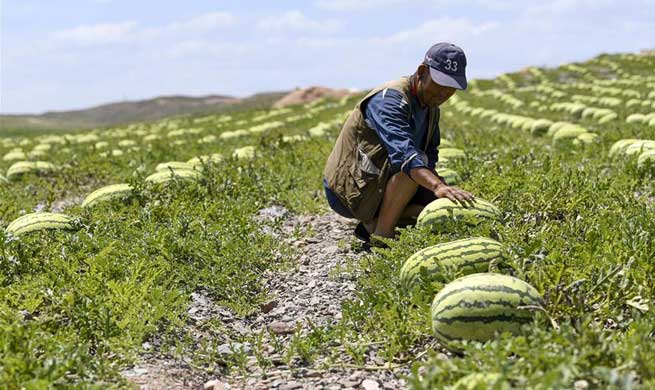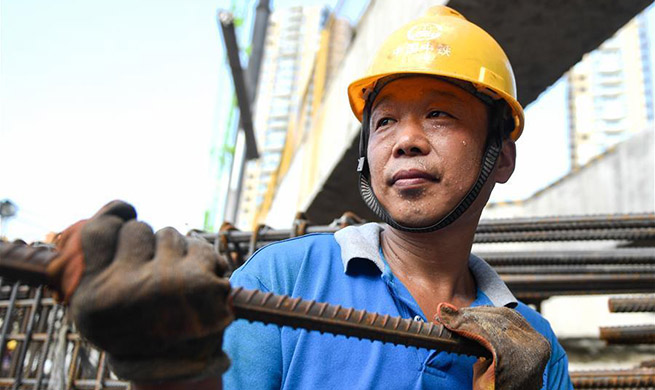by Zhang Jianhua, Wang Shan
VIENTIANE, July 24 (Xinhua) -- "On the same day last year, the dam collapse ruined our homes, but the China-Laos railway project is bringing us new life," 31-year-old Phoutthavan Viengsawan from southern Laos' Sanamxay District of Attapeu Province told Xinhua Tuesday.
July 23, 2018, was a real nightmare, Phoutthavan recounted, at the bridge beam fabrication yard of China Railway No. 2 Group (CREC2) in the capital city of Vientiane.
"The under-construction saddle dam of the Xe-Pian Xe-Namnoy hydropower project collapsed, unleashing a huge amount of water into 13 villages of the Sanamxay district, some 560 km southeast of Vientiane," Phoutthavan recalled.
"Six villages were severely damaged and 42 people lost their lives with 23 still unaccounted for. In total 13,000 people were affected with over 6,000 people left homeless in the floods," said Phoutthavan.
"The paddy fields were destroyed, and the flash flood washed away my chickens and ducks," he remembered painfully, as scenes of horrific floods, landslides, falling trees, broken houses, bridges and roads rushed back to the forefront of his mind.
"The only comfort was that my family all survived the disaster."
The wooden bridge next to Phoutthavan's house was hit and destroyed in July last year, but just a few days later rescue and reconstruction teams had arrived from China.
At the request of Lao government, the Chinese engineering companies, along the China-Laos railway construction sites, have donated cash and materials to the disaster-hit areas and offered assistance to urgently build four bridges for access to the flooded villages of Attapeu Province.
In less than 50 days, the CREC2 and Sinohydro Bureau 10 under China Power, with guidance from the Laos-China Railway Company, completed the construction of four brand-new quality bridges in flooded Attapeu.
To honor the achievement and contribution of the Chinese engineering companies, Lao Prime Minister Thongloun Sisoulith signed an order of commendation for the Laos-China Railway Company, CREC2 and China Power.
On behalf of the government, Lao Minister of Public Works and Transport Bounchan Sinthavong conferred development medals to the three companies last September.
Phoutthavan's life, hence, was also renewed and put on a new track, with the arrival of the Chinese engineering companies.
"They came to my house to build a new bridge, only to find that we had nothing to support our lives, so the Chinese companies recruited us to the (China-Laos railway) project," Phoutthavan told Xinhua.
"So, we followed the Chinese company to Vientiane."
According to Lei Chao, the Communist Party of China (CPC) branch secretary of the CREC2 Vientiane beam fabrication yard, the yard has hired over 200 Attapeu flood-affected villagers as local workers so far.
A fellow from Phoutthavan's hometown, 38-year-old Paly Sipaseuth, is now also working at the CREC2 beam fabrication yard.
"At the very beginning, I could only do some cleaning, and later on the Chinese master worker taught us more complicated tasks. Now I am in charge of a concrete and beam casting team."
Zhao Shengchao, the Chinese master worker Paly referred to, told Xinhua that the Lao workers from Attapeu have become the backbone force at China-Laos railway construction sites.
Paly and Phoutthavan told Xinhua their monthly income can exceed 3 million kips (over 350 U.S. dollars), which is comparatively high among their peers in Vientiane, and their family living standards have improved dramatically.
Paly said that his family have built a two-story house with the money he has been able to send back.
The 414-km China-Laos railway runs from the Boten border gate in northern Laos to Vientiane at an operating speed of 160 km per hour.
Once the railway construction is completed by December 2021, the future still looks bright for Phoutthavan, Paly and their fellows, thanks to the experiences they've gained from the Chinese firms, master workers and new friends.
"If possible, I'll work on the next railway project with Chinese companies, or I will try to get a job on the China-Laos railway when it is operational," Paly told Xinhua.













